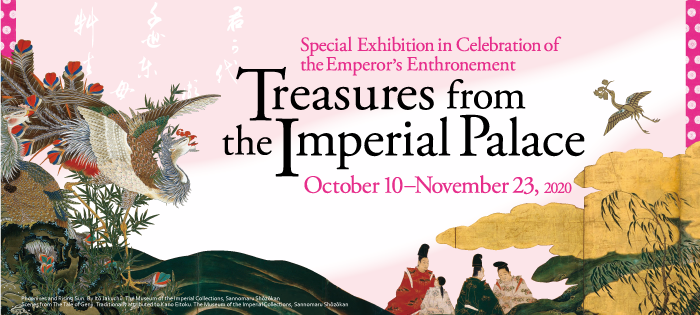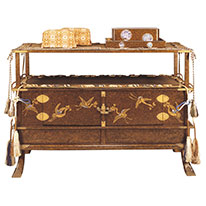General Information
Exhibition dates are subject to change and visitors numbers may be limited in order to prevent the spread of the coronavirus.
| Exhibition Title | Special Exhibition in Celebration of the Emperor's Enthronement Treasures from the Imperial Palace |
||||||||||||
|---|---|---|---|---|---|---|---|---|---|---|---|---|---|
| Period | October 10–November 23, 2020 The exhibition has two installations: Part I: October 10 – November 1, 2020 Part II: November 3 – November 23, 2020 |
||||||||||||
| Venue | Kyoto National Museum, Heisei Chishinkan Wing | ||||||||||||
| Transportation | JR, Kintetsu Railway, Keihan Railway, Hankyu Railway, City Bus | ||||||||||||
| Closed | Mondays except Novemver 23 (national holiday), 2020 | ||||||||||||
| Special Exhibition Hours | 9:30 a.m.–6:00 p.m. (Entrance until 5:30 p.m.) *Evening hours on Fridays and Saturdays have been cancelled. |
||||||||||||
| Special Exhibition Admission |
The Exhibiiton has ENDED.
Timed entry tickets for the Kyoto National Museum special exhibition Treasures from the Imperial Palace must now be reserved online. Please purchase your ticket in advance on the exhibition website specifying your date and time of entry. Tickets for Part I: On sale 10:00 am Friday, Sep. 25 Tickets for Part II: On sale 10:00 am Friday, Oct. 20 How to Reserve and Purchase Tickets Online (English) --ENDED--
|
||||||||||||
| Audio Guide |
Fee 600 yen (includes tax) Time approx. 30 min Language Japanese, English 9:30 a.m.–5:15 p.m. |
||||||||||||
| Catalogue | 2,800 yen. 256 pages. 98 objects. Color plates. Available at the Museum Shop Catalogues of Past Special Exhibitions |
||||||||||||
| Organized by | Kyoto National Museum, Imperial Household Agency, The Yomiuri Shimbun, NHK Kyoto Station, NHK Enterprises, Inc. Osaka Branch Office | ||||||||||||
| With the support of | Iwatani Corporation, Kinden Corporation, Shimizu Corporation, Daiwa House Industry Co., Ltd., Panasonic Corporation, Non-Destructive Inspection Co., Ltd. |
Images from the Exhibit
- I. Masterpieces of Calligraphy and Painting from the Museum of the Imperial Collections, Sannomaru Shōzōkan
- II. The Colors and Forms of the Imperial Palace
In 2019, with the enthronement of the emperor and empress, Japan formally entered into the new Reiwa era. This special exhibition commemorates this celebratory occasion with works from the ancient capital of Kyoto, home to Japan's rich imperial court culture. The exhibition also features masterworks from the Museum of Imperial Collections, the Sannomaru Shōzōkan.
Part I. Masterpieces of Calligraphy and Painting from the Museum of the Imperial Collections, Sannomaru Shōzōkan
The works of art in the Museum of the Imperial Collections, Sannomaru Shōzōkan,
were acquired through various channels, as the imperial family accumulated objects
gradually over successive generations of sovereigns. Though diverse in provenance, the
masterpieces of painting and calligraphy in the imperial holdings include both objects
owned and used by the court up through the Edo period (1615–1868) as well as works
presented for collection by the imperial household since the Meiji period (1868–1912).
Part I of the exhibition introduces these works in four sections: "The Power of
Calligraphy," "Stories Spun in Pictures," "Admiration for Chinese Painting," and "The
Flowering of Early Modern Painting."
The Power of Calligraphy
From the renowned ancient Chinese calligrapher Wang Xizhi (303–361) to the master calligraphers of the Heian period (794–1185) to famous historical figures, the shades and shapes of ink traced by their writings reveal not only the meaning of the words, but also the character of the person holding the brush.
Stories Spun in Pictures
Untie an illustrated handscroll and roll it open, and alternating sections of text and painting reveal themselves before you.
A story evolves as you move through the scroll section by section, holding it open between both hands—an intensely personal viewing experience. The intricately colored imagery unfurling before your eyes can sometimes take your breath away.
Admiration for Chinese Painting
For Japan, surrounded by ocean on four sides, the culture brought over from the Asian continent always held great attraction. Paintings from China and Korea were not only appreciated in their own right, but they were copied and referenced by generations of artists.
The Flowering of Early Modern Painting
The Momoyama (1573–1615) and Edo (1615–1868) periods gave rise to painters of extraordinary individualism and talent. Such artists demonstrated their prowess through folding screens and massive hanging scrolls that, when put on view, had the ability to instantly transform the atmosphere of a room.
Part II. The Colors and Forms of the Imperial Palace
On October 22, 2019 (Reiwa 1), the enthronement ceremony for the new emperor took place with great solemnity at the Tokyo Imperial Palace.
Though few people still remember it, the enthronement of the Shōwa Emperor in 1928 took place not in Tokyo but at the Kyoto Imperial Palace. Though that was the last time accession ceremonies took place in the ancient capital, for centuries before then life in
Kyoto had centered around the emperor, punctuated by recurring rituals, festivities, and annual events.
This part of the exhibition introduces daily life in the Kyoto Imperial Palace through various works of art, offering a firsthand glimpse into a world that no longer exists today. It is divided into four themes: "Enthronement Scenes," "Learning in Chinese, Creating in Japanese," "Portraits of Emperors and the Elegance of Imperial Style," and "The Stage for Courtly Tales."
Enthronement Scenes
Clothed in brilliant red sokutai regalia, the emperor dons a crown decorated with gold and jewels. Through paintings and costumes, we trace past scenes of enthronement at the Kyoto Imperial Palace, which differ from the recent Reiwa accession ceremonies.
Learning in Chinese, Creating in Japanese
The culture of Japan developed through the study of Chinese culture, arts, and learning combined with an aesthetic sensibility rooted in Japanese native customs. This confluence of Japanese and Chinese cultures and the appreciation for both shine through in poetry and calligraphy.
Portraits of Emperors and the Elegance of Imperial Style
The emperor's position has changed with the times, but the role of an elegant sovereign at the helm of Japanese culture has remained consistent throughout the ages. In this section, we trace this regal character through various objects including imperial portraiture and writings brushed by emperors themselves.
The Stage for Courtly Tales
The imperial palace was the setting for courtly narrative literature such as The Tale of Genji. Inside was the Higyōsha, also called the Fujitsubo—the part of the empress's quarters in the imperial palace where the women pining after the Shining rince Genji resided. Through slidingdoor (fusuma) paintings and furnishings, we sneak a peek at the inner palace forbidden to all but a select few.












![Scenes from The Tale of Genji (left screen). Traditionally attributed to Kano Eitoku. The Museum of the Imperial Collections, Sannomaru Shōzōkan [on view: Nov. 3–23, 2020]](../../../jp/special/img/20201010/meiho_20201010_tmb.png)
![Tracing Copy of a Letter, known as Sangluantie (Letter on Bereavement and Disorder). Copied from a calligraphy by Wang Xizhi. The Museum of the Imperial Collections, Sannomaru Shōzōkan [on view: Oct. 10–Nov. 1, 2020]](../../../jp/special/img/20201010/meiho_1-1-1_soran_tmb.jpg)
![Apology for Unsatisfactory Arrow Preparations for the New Year's Archery Contest (Onmeijo-). By Fujiwara no Sukemasa (Sari). The Museum of the Imperial Collections, Sannomaru Shōzōkan [on view: Nov. 3–23, 2020]](../../../jp/special/img/20201010/meiho_1-1-2_onmei_tmb.jpg)
![Illustrated Account of the Mongol Invasion (Mōko shūrai ekotoba), Scroll 2. The Museum of the Imperial Collections, Sannomaru Shōzōkan [this scroll on view: Nov. 3–23, 2020]](../../../jp/special/img/20201010/meiho_1-2-2_mouko_tmb.jpg)
![Illustrated Chronicle of the Miracles of the Kasuga Deity (Kasuga gongen genki e), Scroll 1. Painting by Takashina Takakane. Calligraphy by Takatsukasa Mototada and his descendants. The Museum of the Imperial Collections, Sannomaru Shōzōkan [this scroll on view: Nov. 3–23, 2020]](../../../jp/special/img/20201010/meiho_1-2-1_kasuga_tmb.jpg)
![Phoenixes and Rising Sun. By Itō Jakuchū. The Museum of the Imperial Collections, Sannomaru Shōzōkan [on view: Nov. 3–23, 2020]](../../../jp/special/img/20201010/meiho_1-4-2_phoenix_tmb.jpg)
![Scattered Fans (right screen). By Tawaraya Sōtatsu. The Museum of the Imperial Collections, Sannomaru Shōzōkan [on view: Nov. 3–23, 2020]](../../../jp/special/img/20201010/meiho_1-4-1_fan_tmb.jpg)
![Enthronement of Emperor Reigen. By Kano Einō. Kyoto National Museum [on view: Nov. 3–23, 2020]](../../../jp/theme/upload_images/emperor_2019-1_tmb.jpg)
![Collection of Chinese and Japanese Poems to Sing (Wakan rōeishū), Kumogami (Cloud Paper) Version, Scroll 1. Attributed to Fujiwara no Yukinari. The Museum of the Imperial Collections, Sannomaru Shōzōkan [this scene on view: Nov. 3–23, 2020]](../../../jp/special/img/20201010/meiho_2-2-1_kumo_tmb.jpg)
![Draft of Poetry for Folding Screens. By Ono no Michikaze (Tōfū). The Museum of the Imperial Collections, Sannomaru Shōzōkan [this scene on view: Nov. 3–23, 2020]](../../../jp/special/img/20201010/meiho_2-2-2_tofu_tmb.jpg)
![Portraits of Emperors and Regents (Tenshi sekkan miei) (Emperor Scrolls). By Fujiwara no Tamenobu and Gōshin. The Museum of the Imperial Collections, Sannomaru Shōzōkan [this scene on view: Oct. 10–Nov. 1, 2020]](../../../jp/special/img/20201010/meiho_2-3-1_tenshi_tmb.jpg)
![Important Cultural Property. Waka Poetry on Folded Paper Composed on a Kumano Pilgrimage (Kumano kaishi). By Emperor Go-Toba. Kyoto National Museum [on view: Nov. 3–23, 2020]](../../../jp/theme/upload_images/1F-3_20151215_tmb.jpg)
![Sliding Door Panel Paintings from the Higyōsha (Empress Consort's Quarters of the Imperial Palace). By Tosa Mitsusada and Mitsutoki. Kyoto Office of the Imperial Household Agency [these panels on view: Oct. 10–Nov. 1, 2020]](../../../jp/special/img/20201010/meiho_2-4-1_fusuma_tmb.jpg)

